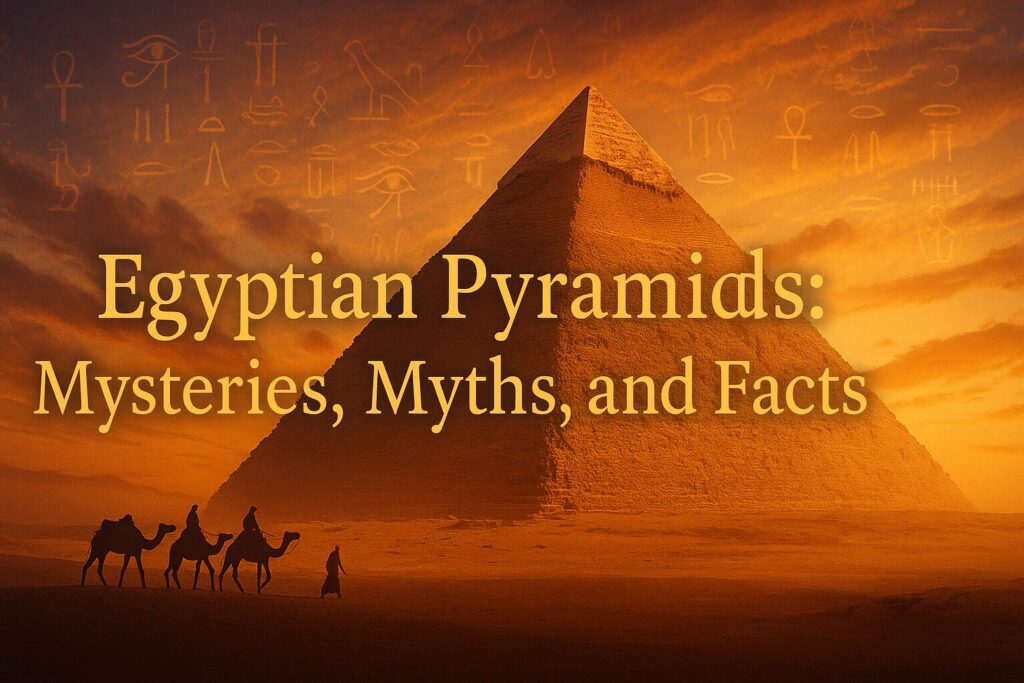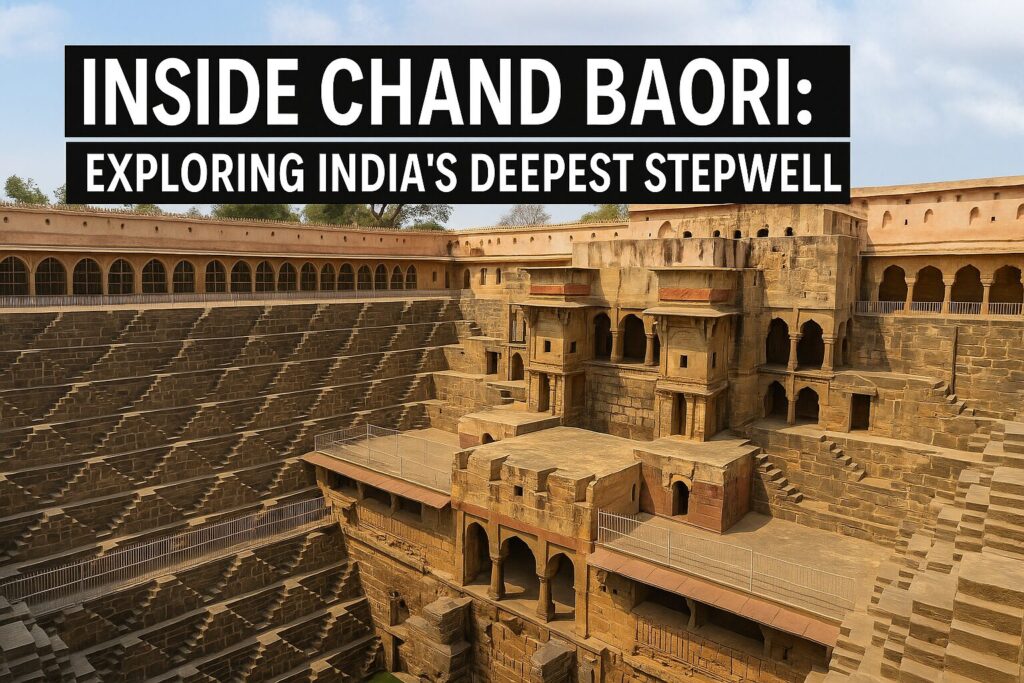Explore the mysteries, myths, facts, and engineering marvels of the Egyptian pyramids history’s greatest architectural and spiritual wonders.
Table of Contents
Introduction
The Egyptian Pyramids stand as some of the most iconic and enduring structures in human history. Towering over the desert landscape for over 4,500 years, these monumental tombs are more than just architectural wonders they are windows into an ancient civilization’s spiritual beliefs, technological prowess, and artistic genius.
But despite centuries of study, the Egyptian Pyramids continue to mystify. Were they mere burial places, or did they serve deeper symbolic purposes? How could ancient builders, without cranes or trucks, move massive stone blocks weighing several tons? And why have so many myths from alien builders to lost Atlantean knowledge persisted around them?
This article explores the mysteries, myths, and facts surrounding the Egyptian Pyramids. From their origin story and interior secrets to their spiritual significance and the engineering feats behind them, we’ll uncover what’s known and what still isn’t about these timeless monuments.
Let’s begin with their origin:
The Origins of the Egyptian Pyramids: When and Why Were They Built
The origins of the Egyptian Pyramids trace back to around 2700 BCE, during the Old Kingdom period often referred to as the “Age of the Pyramids.” But to understand why they were built, we must look beyond the stone and into the belief system and political structure of ancient Egypt.
From Mastabas to Megastructures
Before pyramids, Egyptian elites were buried in mastabas flat-roofed rectangular tombs made of mudbrick. Over time, these evolved into more complex structures. The first major leap came with Djoser’s Step Pyramid at Saqqara, designed by his architect Imhotep around 2667 BCE. This marked the world’s first monumental stone building.
Why Were the Egyptian Pyramids Built?
The purpose of the pyramids was deeply tied to ancient Egyptian religion and the afterlife. Pharaohs were considered divine beings gods on earth and their tombs had to reflect their eternal status.
- Spiritual significance: Egyptians believed in a life after death where the pharaoh would join the gods. The pyramid was a “resurrection machine,” designed to aid the king’s soul in ascending to the heavens.
- Political propaganda: The grandeur of pyramids symbolized the power and divine legitimacy of the ruling dynasty. A grander tomb meant a more powerful king.
- Economic and cultural expression: Building pyramids was also a massive national project involving thousands of workers, craftsmen, and administrators. It helped unify the kingdom under one religious and economic vision.
How Old Are the Egyptian Pyramids?
The oldest known pyramid is the Step Pyramid of Djoser (c. 2667-2648 BCE), but the most famous the Great Pyramid of Giza was constructed during the reign of Khufu (c. 2589-2566 BCE). That makes it over 4,500 years old.
These timelines help answer the popular question often searched online: “Egyptian pyramids how old?” The answer is older than most ancient structures on Earth, including Stonehenge and even some Mesopotamian temples.
Key Takeaway
The Egyptian Pyramids were far more than majestic tombs. They were expressions of divine kingship, cultural identity, and religious devotion built during a time when the line between ruler and deity was practically invisible.
Inside the Pyramids: What Lies Beneath the Stones
Stepping inside the Egyptian Pyramids is like walking into the heart of ancient mystery. While the outside dazzles with geometric precision and monumental scale, the interiors are surprisingly sparse, often narrow, and built with strategic purpose rather than decoration.
Yet what lies beneath these massive stones reveals the deepest beliefs and architectural brilliance of ancient Egypt.
Chambers, Shafts, and Sacred Spaces
Contrary to Hollywood depictions of treasure-filled labyrinths, most Egyptian pyramids particularly those from the Old Kingdom follow a relatively structured internal design:
- Entrance Passage: Usually on the north side, leading downward or upward toward internal chambers.
- Descending and Ascending Corridors: Narrow, stone-lined passages that connect different levels and rooms.
- The King’s Chamber: The main burial chamber, often centrally located and made with massive granite blocks. In the Great Pyramid of Giza, the King’s Chamber is lined with red granite sourced from Aswan, over 800 km away.
- The Queen’s Chamber: A secondary chamber; its true purpose is still debated. Some think it may have held ceremonial functions or symbolic significance.
- Air Shafts: These narrow tunnels were once believed to provide ventilation, but new theories suggest they may align with stars, connecting the pharaoh’s soul to the heavens.
- The Grand Gallery: Found in the Great Pyramid, it’s an architectural marvel a long, steep corridor with a corbelled roof, leading to the King’s Chamber.
Sarcophagi and Burial Items
While pyramids were intended as tombs, most have been found empty. Over centuries, they were looted or possibly never completed. Still, archaeologists have discovered:
- Stone sarcophagi (often without mummies)
- Traces of burial goods, like pottery, tools, and ritual items
- Hieroglyphic inscriptions, especially in later pyramids, like those at Saqqara and Dahshur
One key example is the Pyramid Texts found in the Pyramid of Unas the earliest known religious texts in the world. These spells were meant to guide the pharaoh safely into the afterlife.
Hidden Chambers and Ongoing Discoveries
In 2017, researchers using muon tomography discovered a previously unknown void above the Grand Gallery in the Great Pyramid of Giza. Its purpose remains unknown, sparking global intrigue.
Even today, much remains hidden. Advanced imaging technologies continue to uncover anomalies, hinting at more chambers and hidden secrets within these ancient structures.
In Summary
Inside the Egyptian Pyramids lies a world shaped by spirituality, symbolism, and elite engineering. They weren’t treasure vaults but sacred passageways to eternity — built to honor, protect, and immortalize the divine ruler for all time.
Engineering Genius: How Were the Pyramids Constructed Without Modern Tools?
Perhaps the most enduring mystery surrounding the Egyptian Pyramids is how they were constructed. Built over 4,500 years ago, without cranes, concrete, or wheel-based machinery, these colossal structures still defy modern comprehension. The Great Pyramid of Giza alone contains over 2.3 million limestone and granite blocks, some weighing up to 80 tons. Yet it stands within less than a quarter of a degree of true north an astonishing feat of precision.
So, how did ancient builders achieve this?
Labor and Logistics: More Organized Than You Think
Contrary to the myth of slave labor, archaeological evidence suggests the pyramids were built by a well-fed, highly skilled workforce:
- Around 20,000–30,000 workers were likely involved at Giza at any one time.
- Workers lived in permanent, planned communities with bakeries, breweries, and medical care.
- They were likely seasonal laborers farmers who worked on the pyramids during Nile flood periods when fields were underwater.
Quarrying and Transporting Massive Stones
- Limestone was quarried nearby, while granite blocks were transported from Aswan nearly 900 km south likely via the Nile.
- Recent discoveries show wetting the sand in front of sleds reduced friction, allowing stones to be dragged more easily a technique demonstrated in both ancient art and modern physics experiments.
Construction Techniques: Ramps, Levers, and Ingenuity
Though there’s no definitive blueprint, several well-supported theories explain how the Egyptian Pyramids were constructed:
- Straight or zigzagging ramps: Built alongside or around the pyramid, ramps allowed blocks to be hauled upward.
- Internal spiral ramps: French architect Jean-Pierre Houdin proposed that internal spiral ramps were used, supported by 3D scans of the Great Pyramid’s structure.
- Levers and counterweights: Workers may have used large wooden levers, ropes, and fulcrums to lift and position blocks with surprising accuracy.
Precision Without Metal Tools
Egyptians used copper chisels, dolerite pounders, and sand for polishing. Their alignment skills are especially mind-blowing:
- The Great Pyramid’s base is almost perfectly square, with sides differing by less than 5 cm.
- The layout of the Giza pyramids mirrors Orion’s Belt, suggesting sophisticated astronomical knowledge.
Modern Admiration
Engineers today still marvel at the structural integrity of these monuments. The fact that the Great Pyramid has survived millennia of earthquakes, erosion, and human interference is a testament to ancient Egypt’s engineering brilliance.
Final Thought
The Egyptian Pyramids weren’t just built they were orchestrated, like a symphony of manpower, mathematics, and material science. Their enduring presence is not just a marvel of stone, but of strategy.
Pyramid Myths: Aliens, Lost Civilizations, and Hidden Knowledge
The Egyptian Pyramids have inspired countless theories some rooted in science, others in speculation. From ancient aliens to Atlantean engineers, the sheer scale and mystery of these monuments have fueled centuries of alternative ideas. While fascinating, many of these myths lack credible evidence and often distract from the genuine ingenuity of ancient Egyptian civilization.
Let’s explore the most popular pyramid myths and the truths behind them.
Myth 1: Aliens Built the Pyramids
One of the most enduring and widely circulated ideas is that extraterrestrials helped build the Egyptian Pyramids. Proponents point to:
- The size and weight of the stones
- The pyramid’s alignment with stars
- Supposed “impossible” precision without modern tools
The Reality:
No evidence archaeological or astronomical supports this. Ancient inscriptions clearly show human involvement in pyramid construction, from laborers’ graffiti to logistical planning carved on stone blocks. Scholars widely agree that the Egyptians themselves, with centuries of architectural evolution and massive labor coordination, were fully capable.
Myth 2: Hidden Chambers Contain Secret Knowledge or Curses
The idea of a “Hall of Records” or lost Atlantean knowledge being hidden beneath the pyramids comes from occult theories, not history. Some link the Sphinx and Great Pyramid to mystical codes predicting future events.
The Reality:
While it’s true that discoveries like the 2017 void above the Grand Gallery have sparked curiosity, no ancient texts or credible excavations point to any hidden libraries or supernatural secrets. Most tomb curses were symbolic, designed to deter robbers not supernatural threats.
Myth 3: The Pyramids Were Built Using Lost Technology
The myth suggests the ancient Egyptians had access to advanced energy systems, sound levitation, or anti-gravity devices and that this knowledge was later lost or hidden.
The Reality:
Again, there’s no evidence. However, what we do know is that ancient Egyptians had profound knowledge of:
- Geometry and engineering principles
- Material sciences (e.g., stone density and durability)
- Astronomy, using stars for alignment
What appears “impossible” is often a reflection of underestimating ancient intelligence and overestimating our own.
Why Do These Myths Persist?
- The pyramids represent a scale of ambition rarely matched even today.
- Many original tools and records have been lost to time, creating gaps filled by speculation.
- Popular culture movies, TV shows, and books often sensationalize pyramid lore.
Appreciating the Real Magic
In truth, the real mystery isn’t aliens or ancient lasers it’s how a Bronze Age civilization mobilized tens of thousands of people, mastered astronomical alignment, and engineered structures that have stood for millennia.
That achievement deserves more admiration than any science-fiction fantasy.
Symbolism and Spiritual Meaning of the Pyramids in Ancient Egypt
To truly understand the Egyptian Pyramids, we must look beyond their physical structure and into their symbolic purpose. In ancient Egypt, architecture was never just functional it was deeply spiritual, layered with metaphysical meaning tied to the cosmos, gods, and the eternal soul.
The Pyramid Shape: A Sacred Geometry
The pyramid’s shape was not arbitrary. It symbolized multiple ideas:
- The primordial mound: In Egyptian creation myths, the world began as a formless sea (Nun) until a mound of earth (the Benben stone) emerged. The pyramid, with its sloping sides rising to a point, mirrors this sacred mound.
- The rays of the sun: The sharp angles and upward tapering design symbolized the sun’s rays, guiding the pharaoh’s soul to the sky to reunite with the sun god Ra.
- Stairway to heaven: Some believe the pyramid represented a celestial ladder for the king’s ka (spirit) to ascend to the afterlife.
Alignment with the Cosmos
The Egyptian Pyramids, especially those at Giza, weren’t just marvels of geometry they were cosmological blueprints.
- The Great Pyramid is aligned almost perfectly with true north, and its sides align with the four cardinal directions.
- The three Giza pyramids mirror Orion’s Belt, believed to be connected to Osiris, the god of the afterlife.
- Interior shafts may have aligned with specific stars, including Sirius and Orion, believed to be gateways for the soul’s ascension.
This celestial alignment shows the Egyptians didn’t separate religion and science they used astronomy as theology, building a tangible bridge between heaven and earth.
Death, Resurrection, and Eternal Life
Pyramids were not just tombs they were resurrection engines:
- The embalmed body, buried deep within, was protected by thick stone and sacred spells (like those found in the Pyramid Texts).
- The orientation and symbolism were meant to help the pharaoh achieve immortality.
- The structure itself was a monument to eternity, built of stone to defy decay and preserve divine order (ma’at).
Spiritual Hierarchy
The pyramid was also a symbol of divine hierarchy broad at the base (earthly life) and narrowing toward the apex (divine unity). This echoed the social and spiritual structure of Egyptian society, with the pharaoh as the god-king standing between mortals and the gods.
A Living Monument
Even centuries after their construction, pyramids were venerated by priests, pilgrims, and rulers. Some pharaohs built their own pyramids near older ones to connect themselves to the divine legacy of their ancestors.
The Egyptian Pyramids were, above all, sacred expressions of a people who believed deeply in life after death, cosmic order, and the divine nature of kingship.
Top 5 Most Famous Egyptian Pyramids and What Makes Them Unique
While there are over 100 pyramids scattered across Egypt, only a handful have truly stood the test of time both physically and in the public imagination. Each of the top five Egyptian Pyramids offers a unique story, design, and significance, showcasing the evolution of pyramid construction and ancient Egyptian civilization itself.
1. The Great Pyramid of Giza (Pyramid of Khufu)
- Location: Giza Plateau
- Built For: Pharaoh Khufu (also known as Cheops)
- Date: Around 2580-2560 BCE
- Unique Features:
- The largest pyramid ever built originally 146.6 meters tall.
- Contains the King’s Chamber, Queen’s Chamber, Grand Gallery, and mysterious air shafts.
- Aligned almost perfectly with true north.
- Built with over 2.3 million limestone blocks.
- Was the tallest man-made structure in the world for over 3,800 years.
This is the most studied and admired of all Egyptian Pyramids and the only surviving Wonder of the Ancient World.
2. The Pyramid of Khafre
- Location: Giza
- Built For: Pharaoh Khafre (son of Khufu)
- Date: Around 2558-2532 BCE
- Unique Features:
- Appears taller than Khufu’s pyramid due to its elevated position, though it’s slightly smaller.
- Still retains some original casing stones at the top offering a rare glimpse into how all pyramids once looked.
- Associated with the Great Sphinx, believed to bear Khafre’s likeness.
Khafre’s pyramid exemplifies the refined balance between architecture and royal symbolism.
3. The Red Pyramid (North Pyramid)
- Location: Dahshur
- Built For: Pharaoh Sneferu (father of Khufu)
- Date: Around 2613-2589 BCE
- Unique Features:
- Considered the first successful “true” pyramid (smooth-sided).
- Named for its reddish limestone exterior.
- Stands 105 meters tall and marks the transition from step pyramids to classic geometry.
This was the culmination of earlier experiments, including the failed Meidum Pyramid and the Bent Pyramid.
4. The Bent Pyramid
- Location: Dahshur
- Built For: Pharaoh Sneferu
- Date: Around 2600 BCE
- Unique Features:
- Unusual double slope lower portion rises at 54°, then shifts to 43.5°.
- One of the few pyramids that retains a large portion of its smooth outer casing.
- Suggests real-time adjustments during construction due to stability concerns.
This pyramid is a brilliant case study in ancient engineering trial and error and adaptation.
5. The Step Pyramid of Djoser
- Location: Saqqara
- Built For: Pharaoh Djoser
- Date: Around 2670 BCE
- Unique Features:
- The oldest stone building of its size and scale in the world.
- Designed by Imhotep, who is often considered the first recorded architect.
- Composed of six mastaba-like layers stacked to form a step pyramid.
This pyramid marks the birth of monumental stone architecture in Egypt and perhaps the entire world.
Each of these Egyptian Pyramids reflects a technological leap and a deeper spiritual ideology. Together, they form a timeline of ancient ambition, trial, and mastery — revealing a civilization in constant pursuit of eternity.
Conclusion
The Egyptian Pyramids are more than ancient tombs they are timeless symbols of a civilization’s highest ideals, achievements, and mysteries. From the earliest step pyramid of Djoser to the towering majesty of the Great Pyramid of Khufu, these structures reflect not only remarkable engineering but also a rich spiritual vision that linked pharaohs with the gods and eternity.
Despite centuries of exploration and study, the Egyptian Pyramids still inspire wonder. How did ancient builders align massive stones with the stars? What secrets might still lie hidden in undiscovered chambers? And why do so many myths persist around their origins?
The truth is just as fascinating as the fiction. The pyramids were not built by aliens or lost super-civilizations but by skilled human hands, guided by religious belief, astronomical knowledge, and a desire for immortality. Their precision, endurance, and spiritual depth continue to challenge our assumptions about what ancient humans were capable of.
Today, the Egyptian Pyramids remain among the most visited and studied monuments on Earth. They are not only testaments to Egypt’s past but also enduring monuments to human curiosity, innovation, and the pursuit of legacy.
And as modern technologies from 3D scans to muon imaging peel back their layers, one thing becomes clear: the story of the pyramids is still unfolding.





